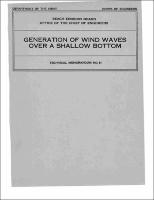Please use this identifier to cite or link to this item:
https://hdl.handle.net/11681/3430| Title: | Generation of wind waves over a shallow bottom |
| Authors: | Texas A & M University United States. Army. Office of the Chief of Engineers Bretschneider, Charles L., 1920- |
| Keywords: | Winds Water waves Shallow waters Shallow waves Numerical models Bottom friction percolation |
| Publisher: | United States, Beach Erosion Board Engineer Research and Development Center (U.S.) |
| Series/Report no.: | Technical memorandum (United States. Beach Erosion Board) ; no. 51. |
| Description: | Technical Memorandum Abstract: A numerical method is presented in this report for determining the generation of wind waves over a shallow bottom, taking bottom friction and percolation in the permeable sea bottom into account. To date as far as the author knows, there has been no single theoretical development for determining the actual growth of waves generated by winds blowing over relatively shallow water. The numerical method presented in this report is essentially that of successive approximations wherein wave energy is added due to wind stress and subtracted due to bottom friction and percolation. This is done by making use of the deep water forecasting relationships originally developed by Sverdrup and Munk (6) and revised by Bretschneider (2) for determining the energy added due to wind stress. The amount of wave energy loss due to bottom friction and percolation is determined from the relationships developed by Bretschneider and Reid (3). The resultant wave heights and periods are obtained by combining the above relationships by numerical methods. The basic assumptions applicable to the development of the deep water wave generation relationships (2) as well as the development of the relationships for bottom friction loss (4) and percolation loss (5) apply to the development in this report. For a detailed discussion of these basic assumptions, the reader is referred to the list of references at the end of this report. Empirical data on wind generated waves in shallow water obtained from the Gulf of Mexico will be presented in a separate technical report at a later date. Although there are insufficient wave data to date to verify completely all relationships presented in this report, it is believed that the method will prove satisfactory once sufficient wave data become available to enable accurate evaluation of the constants. |
| Rights: | Approved for Public Release, Distribution is Unlimited |
| URI: | http://hdl.handle.net/11681/3430 |
| Appears in Collections: | Technical Memorandum |
Files in This Item:
| File | Description | Size | Format | |
|---|---|---|---|---|
| BEB-TM-51.pdf | 11.27 MB | Adobe PDF |  View/Open |